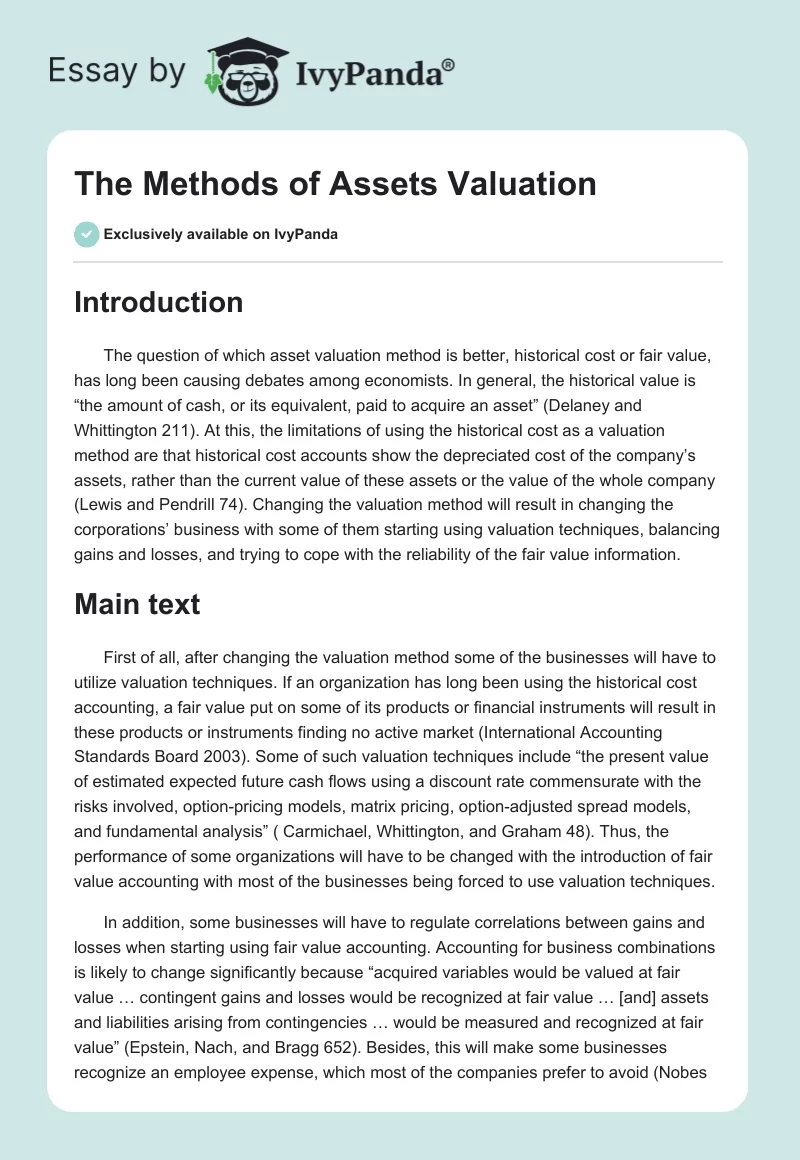Introduction
The question of which asset valuation method is better, historical cost or fair value, has long been causing debates among economists. In general, the historical value is “the amount of cash, or its equivalent, paid to acquire an asset” (Delaney and Whittington 211). At this, the limitations of using the historical cost as a valuation method are that historical cost accounts show the depreciated cost of the company’s assets, rather than the current value of these assets or the value of the whole company (Lewis and Pendrill 74). Changing the valuation method will result in changing the corporations’ business with some of them starting using valuation techniques, balancing gains and losses, and trying to cope with the reliability of the fair value information.
Main text
First of all, after changing the valuation method some of the businesses will have to utilize valuation techniques. If an organization has long been using the historical cost accounting, a fair value put on some of its products or financial instruments will result in these products or instruments finding no active market (International Accounting Standards Board 2003). Some of such valuation techniques include “the present value of estimated expected future cash flows using a discount rate commensurate with the risks involved, option-pricing models, matrix pricing, option-adjusted spread models, and fundamental analysis” ( Carmichael, Whittington, and Graham 48). Thus, the performance of some organizations will have to be changed with the introduction of fair value accounting with most of the businesses being forced to use valuation techniques.
In addition, some businesses will have to regulate correlations between gains and losses when starting using fair value accounting. Accounting for business combinations is likely to change significantly because “acquired variables would be valued at fair value … contingent gains and losses would be recognized at fair value … [and] assets and liabilities arising from contingencies … would be measured and recognized at fair value” (Epstein, Nach, and Bragg 652). Besides, this will make some businesses recognize an employee expense, which most of the companies prefer to avoid (Nobes and Parker 180). In this way, the businesses may face losses when changing the valuation method to fair value accounting with most of them being induced to disclose the expenses which they preferred to hide when using historical cost accounting.
Finally, the performance of the companies for which cash is the only asset will change significantly if they start using fair value accounting. Based on the fair value such organizations “are liable to report a return on capital that may be seriously misleading, and they create a positive incentive to ‘short-termism’ because the reported ‘fair value’ return is distorted by the volume of activity” (Rayman 90). This all leads to fair value information becoming inaccurate and unreliable, which may lead to the lowering of a firm’s credit rating due to the adverse information about this firm’s future earnings (Ho and Yi 573). Therefore, the performance of some businesses will change and in some cases, these changes may not be positive.
Conclusion
In conclusion, since the difference between the historical value and the fair value is immense, changing the methods of assets valuation may sometimes involve considerable changes for the organizations. In some cases, it will be enough for the firms to use valuation techniques to cope with the problems arising due to the change in the valuation method. In other cases, however, the firms may be unable to balance between gains and losses, which may lead to their bankruptcy.
Works Cited
“Disclosure of the Impact of Corporations on Society.” United Nations Conference on Trade and Development. New York and Geneva, 2004. Web.
Braithwaite, John and Drahos, Peter. Global Business Regulation. Cambridge: Cambridge University Press, 2000.
Carmichael, Douglas R., Whittington, Ray, and Graham, Lynford. Accountant’s Handbook. New York: John Wiley and Sons, 2007.
Delaney, Patrick R. and Whittington, Ray O. Wiley CPA Exam Review 2009: Financial Accounting and Reporting. New York: John Wiley and Sons, 2008.
Epsteain, Barry J., Nach, Ralph, and Bragg, Steven M. Wiley GAAP 2008: Interpretation and Application of Generally Accepted Accounting Principles. New York: John Wiley and Sons, 2007.
Ho, Thomas S. and Yi, Sang-Bin. The Oxford Guide to Financial Modeling: Applications for Capital Markets, Corporate Finance, Risk Management, and Financial Institutions. Oxford: Oxford University Press US, 2004.
Idowu, Samuel O. and Filho, Walter L. Professionals Perspectives of Corporate Social Responsibility. London: Springer, 2009.
International Accounting Standards Board. International Financial Reporting Standards (IFRSs) 2008: Including International Accounting Standards (IASs) and Interpretations as Approved in 2008. Amsterdam: Kluwer, 2008.
Jaarverslaggeving, R. Annual Report Guideline 400: Version 2003. Amsterdam: Kluwer, 2004.


